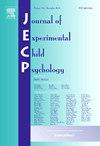Sharpening the number sense: Developmental trends in numerosity perception
IF 1.8
2区 心理学
Q3 PSYCHOLOGY, DEVELOPMENTAL
引用次数: 0
Abstract
Numerosity perception, the ability to process and estimate the number of objects in a set without explicitly counting, has been widely studied, and one well-established finding is that children become more accurate at perceiving numerosity with age. The question remains, however, what the underlying cognitive processes and mechanisms are that drive this improvement. Some authors have suggested that this is due to an increased numerical precision (i.e., the sharpening hypothesis), whereas others have proposed that the more accurate performance is due to the improved ability to inhibit non-numerical features of the display such as object size and spacing of items (i.e., the filtering hypothesis). The current study examined the developmental trajectory of numerosity perception across three age groups (M = 5.65, M = 11.03, and M = 20.10 years). As expected, more accurate performance was observed with age. Regression and analyses of variance revealing the contribution of numerical and non-numerical predictors in performance show that the performance in all age groups was primarily driven by numerical information and that its contribution increased with age. In addition, a consistent bias toward non-numerical features was observed in all age groups. These results support the sharpening hypothesis for children from 5 years of age to early adulthood, suggesting that from this age onward children increasingly focus on numerical information as they get older. These results have important implications for the understanding of the development and specific improvements of numerical perception.
锐化数感:数字感知的发展趋势
数字感知,即在不明确计数的情况下处理和估计一组物体数量的能力,已经得到了广泛的研究,其中一个公认的发现是,随着年龄的增长,儿童对数字的感知变得更加准确。然而,问题仍然是,驱动这种改进的潜在认知过程和机制是什么。一些作者认为,这是由于数值精度的提高(即锐化假设),而另一些人则提出,更准确的性能是由于抑制显示的非数值特征(如对象大小和项目间距)的能力的提高(即过滤假设)。本研究考察了3个年龄组(M = 5.65岁、M = 11.03岁和M = 20.10岁)的数字感知发展轨迹。正如预期的那样,随着年龄的增长,观察到的表现更准确。数值和非数值预测因子对成绩贡献的回归和方差分析表明,所有年龄组的成绩主要受数值信息的驱动,其贡献随着年龄的增长而增加。此外,在所有年龄组中都观察到对非数字特征的一致偏见。这些结果支持了从5岁到成年早期儿童的锐化假设,表明从这个年龄开始,随着年龄的增长,儿童越来越关注数字信息。这些结果对理解数字感知的发展和具体改进具有重要意义。
本文章由计算机程序翻译,如有差异,请以英文原文为准。
求助全文
约1分钟内获得全文
求助全文
来源期刊

Journal of Experimental Child Psychology
Multiple-
CiteScore
4.50
自引率
7.70%
发文量
190
期刊介绍:
The Journal of Experimental Child Psychology is an excellent source of information concerning all aspects of the development of children. It includes empirical psychological research on cognitive, social/emotional, and physical development. In addition, the journal periodically publishes Special Topic issues.
 求助内容:
求助内容: 应助结果提醒方式:
应助结果提醒方式:


